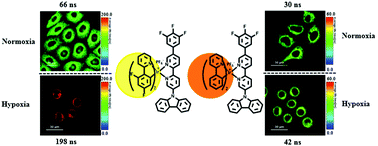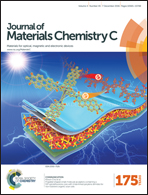A series of iridophosphors with tunable excited states for hypoxia monitoring via time-resolved luminescence microscopy†
Abstract
Hypoxia has been demonstrated to be associated with various diseases, such as cardiovascular diseases, stroke, and solid tumors. Hence, accurate determination of the oxygen content in biological systems is of great importance for disease diagnosis and therapy evaluation. Since the sensitivity of phosphorescent transition-metal complexes (PTMCs) to oxygen is dependent on their excited state properties. Hence, the rational tuning of the excited state of PTMCs is important to design excellent probes for oxygen. In this work, we designed and prepared four novel Ir(III) complexes (Ir1–Ir4) with two N^N ligands bearing carbazolyl and 1,2,3-trifluorobenzene. We confirmed that the complexes mainly originating from the 3ILCT excited state have a longer emission lifetime, resulting in a better oxygen sensitivity than those from the 3MLCT excited state. Additionally, Ir1 has been used for the detection of the intracellular oxygen distribution under complex conditions through time-resolved luminescence imaging (TRLI) techniques. Importantly, TRLI techniques can not only improve the accuracy of the intracellular O2 detection compared to intensity-based methods, but also minimize the short-lived fluorescence interference and improve the signal-to-noise ratio.

- This article is part of the themed collection: 2016 Journal of Materials Chemistry C Hot Papers

 Please wait while we load your content...
Please wait while we load your content...